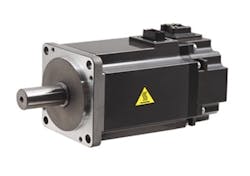Hamrick Manufacturing is well-known in the packaging industries for its end-of-line equipment, such as case sealers, packers, and erectors, as well as pick-and-place machinery and specialty equipment. The company works with a several automation suppliers to create its equipment, so when a customer wanted a machine developed to pick and pack a variety of different protein powders in containers with intricate and delicate labels, Hamrick realized this new machine would require precisely controlled automation to protect the labels and allow for fast and easy changeovers between different products.
This customer runs “about 20 different SKUs on this line," says Jeff Eckstein, controls engineering manager at Hamrick. "They could run one product for a week or two straight, then they might run three different ones in a day. They wanted to speed up the process and remove any sort of operator error during changeovers” by automating the process. The customer’s fillers run 40+ bottles a minute, so any delays in changeover adds up to a lot of bottles not being processed.
Sizing of the motors was critical, because we’re “putting them inside of a 17-axis mechanical assembly that really didn't leave much room for motors," says Eckstein.
The EtherNet/IP amplifier is another important component of the new machine’s design as it allows a non-Mitsubishi controller to work seamlessly with the Mitsubishi motors and drives.
"The thing that I really like about the EtherNet/IP integration between the PLC and the Mitsubishi Electric drives is that all the motion control is done inside the drive,” says Eckstein. “All the behind the scenes work that it takes to make a servo go from point A to point B, plus how fast it gets there and how quickly it slows down—the math, the algorithms and the programming—it all gets taken care of inside the servo drive. That means the PLC can be non-motion rated, so we could go with a much less expensive PLC."
The use of Mitsubishi Electric motors and drives on this new machine deliver greater accuracy, says Eckstein, as well as greater output “because the motors are less likely to fail." Plus, the new machine will dramatically reduce changeover time from 30 minutes to 40 seconds, according to Eckstein.
"[For this machine] we just standardized on Mitsubishi Electric components," Eckstein notes. "And the machine that we ultimately developed has enough precise control to softly place each package. It's extremely gentle."
Leaders relevant to this article:




